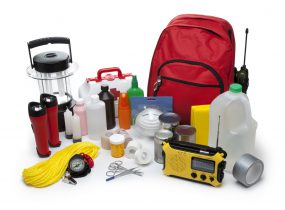Your Ultimate Emergency Preparedness Resource: Stay Informed, Stay Safe
Your Ultimate Emergency Preparedness Resource: Stay Informed, Stay Safe
Blog Article
Just How to Create a Detailed Emergency Preparedness Plan
In the world of readiness, developing a thorough emergency situation plan is not just a task to inspect off a checklist; it is an important cornerstone of any kind of company or person's resilience strategy. By diligently crafting a strategy that addresses numerous elements of emergency monitoring, including risk analysis, communication methods, resource allowance, and tactical decision-making, one can lay a strong structure for guarding operations, assets, and lives.
Importance of Emergency Preparedness
Emergency preparedness is essential for mitigating possible risks and making sure the security of communities and people. In today's globe, where all-natural catastrophes, public health and wellness crises, and other emergencies can strike without caution, being prepared can make a significant difference in lessening the effect of these events. By having a well-thought-out emergency situation preparedness strategy in location, people and companies can react efficiently, protect lives, and decrease home damages.
One of the main reasons why emergency situation readiness is crucial is its role in conserving lives. Having a strategy that outlines clear procedures for emptying, emergency, and interaction action can assist individuals act swiftly and emphatically when emergency situations happen (dig this). This can protect against injuries and fatalities by making sure that people recognize what steps to require to stay safe
In addition, emergency readiness boosts the strength of neighborhoods. By cultivating a culture of readiness and preparation for numerous situations, communities can get better a lot more rapidly from interruptions and calamities. This durability is crucial for maintaining stability, connection of procedures, and total health despite misfortune.
Assessing Potential Risks
Taking into consideration the importance of being gotten ready for unpredicted events, the first action in creating a reliable emergency preparedness plan entails completely evaluating and evaluating potential risks. This analysis calls for a thorough evaluation of all feasible hazards that can impact the company, considering elements such as location, market, and historical information on cases. By determining these dangers, organizations can prioritize their readiness efforts and allocate resources effectively to reduce one of the most significant hazards.
Usual dangers that companies might deal with consist of all-natural calamities like floodings, quakes, or cyclones, technical hazards such as power failures or data violations, along with human-caused threats like mishaps or willful acts of physical violence. Performing a danger evaluation also entails thinking about the possible influence of these occasions on the organization's operations, staff members, consumers, and credibility. By conducting a detailed risk evaluation, companies can create customized emergency situation reaction strategies that address their specific vulnerabilities and make sure reliable preparedness for any type of prospective crisis.
Creating a Communication Strategy
Creating a clear and comprehensive communication plan is important for reliable emergency situation readiness within organizations. In times of dilemma, communication plays an essential role in ensuring the safety and security and well-being of staff members, stakeholders, and the neighborhood. A well-balanced interaction plan ought to detail clear lines of communication, designate vital personnel in charge of interaction jobs, and establish protocols for sharing info quickly and accurately.
One trick facet of developing a communication plan is recognizing main and alternate interaction channels (EMERGENCY PREPAREDNESS). These can include e-mail, text messaging, phone trees, social networks platforms, and public address systems. It is important to guarantee that these networks are dependable, obtainable, and regularly examined to guarantee their effectiveness throughout emergencies

Structure an Emergency Situation Kit
Provided the crucial relevance of readiness in times of crisis, an essential element that organizations have to address is the facility of an emergency situation kit. When constructing an emergency set, it is essential to take into consideration the details demands and circumstances of the company. Furthermore, organizations should consist of essential files, such as contact checklists, insurance policy info, and emergency situation action strategies, in waterproof containers within the package.
Establishing Evacuation Treatments
To ensure the safety and security and orderly discharge of personnel throughout emergency situations, companies must develop efficient and clear discharge treatments. Discharge treatments need to include a series of potential scenarios, including fires, all-natural catastrophes, or other emergency situations that call for speedy evacuation.

Additionally, organizations should develop a system for accounting for all personnel during an emptying to make sure that everybody has securely left the properties. Communication plays an essential duty in evacuation procedures, with clear directions on exactly how to evacuate and when to do so. Regular evaluation and updating of emptying treatments based upon feedback and transforming scenarios are important to keeping the performance of the strategy.
Final Thought
To conclude, establishing an extensive emergency situation preparedness plan is crucial for making certain the safety and security and health of people in the occasion of a catastrophe (EMERGENCY PREPAREDNESS). By examining prospective risks, producing a communication plan, building an emergency package, and establishing evacuation organizations, people and procedures can be better equipped to respond efficiently to emergency situations. It is essential to prioritize preparedness initiatives to mitigate the effect of calamities and protect lives and home
In the world of preparedness, developing a comprehensive emergency situation strategy is not merely a task to inspect off a list; it is a necessary keystone of any kind of company or individual's resilience technique. When emergency situations take place, having a plan that outlines clear procedures for emergency situation, discharge, and communication feedback can aid people act swiftly and emphatically. why not find out more. By performing a detailed danger analysis, organizations can create tailored emergency response strategies that address their certain vulnerabilities and guarantee efficient preparedness for any kind of prospective crisis
Creating a clear and comprehensive communication plan is necessary for efficient emergency situation readiness within organizations. By assessing prospective risks, creating an interaction plan, building an emergency situation package, and developing emptying companies, individuals and procedures can be better equipped to react effectively to emergency situations.
Report this page